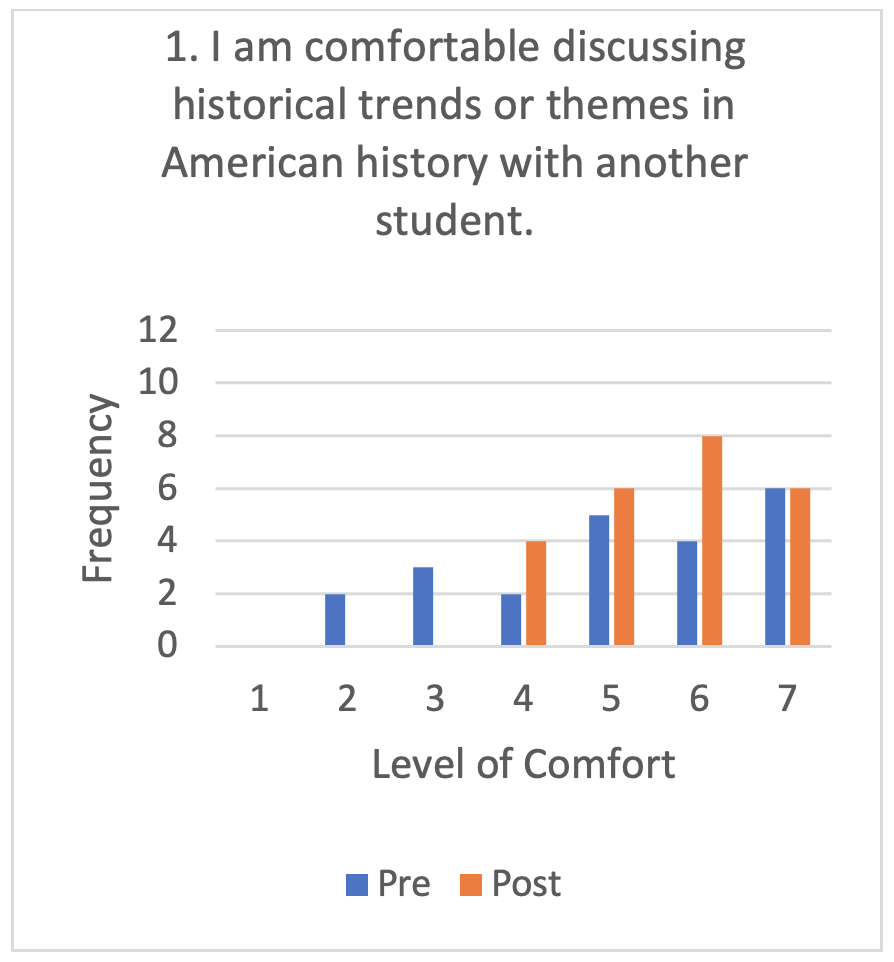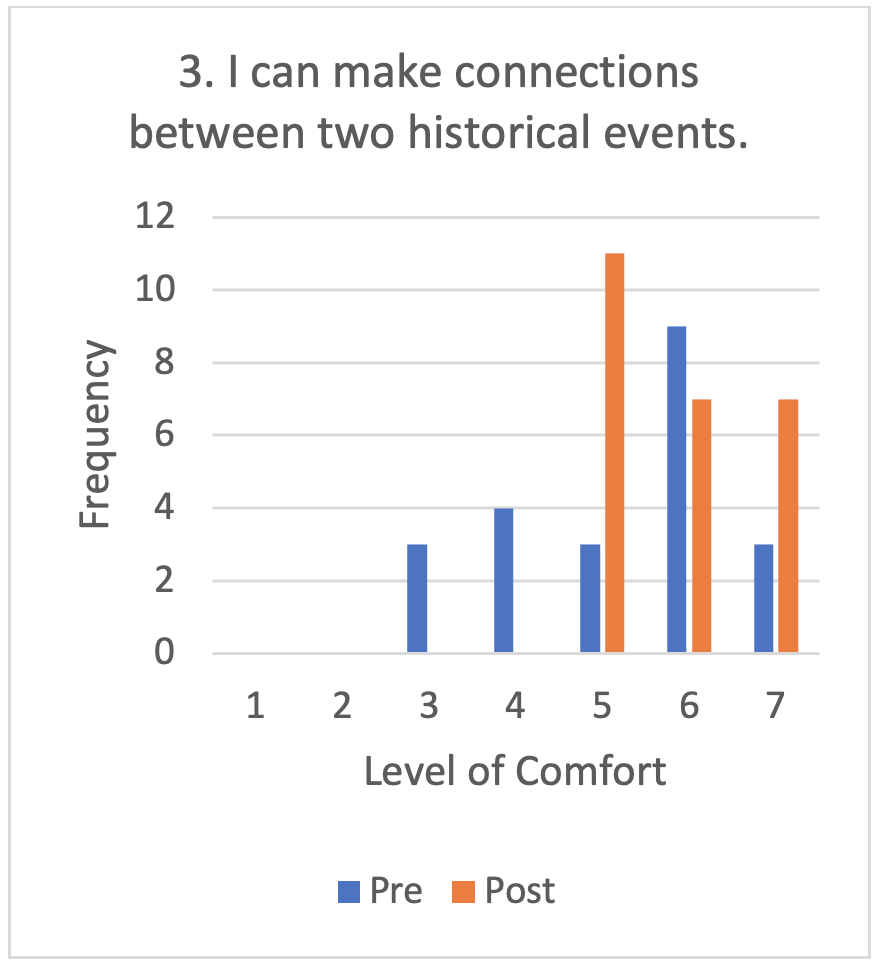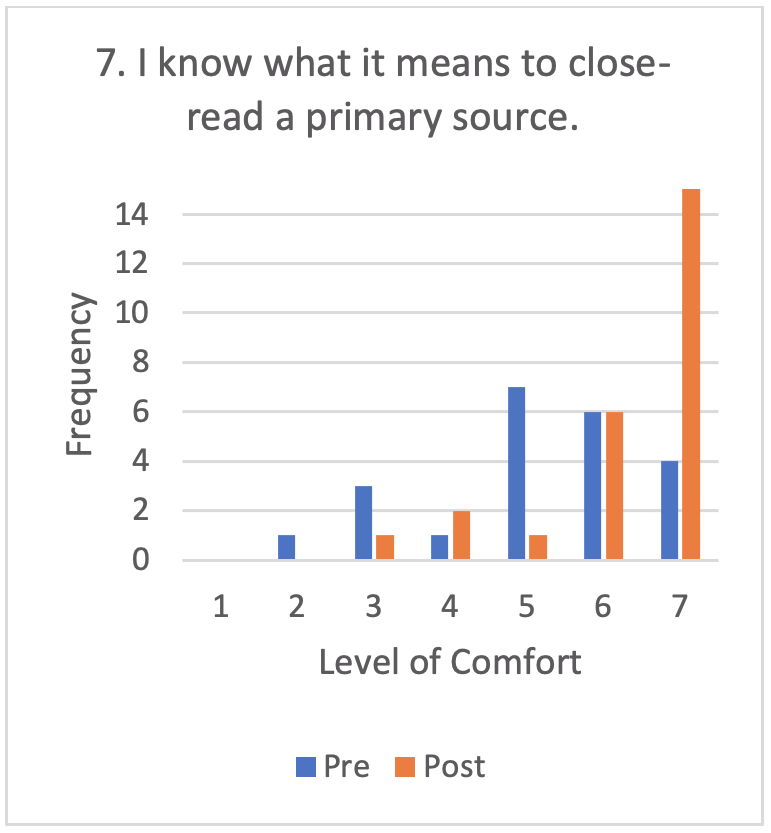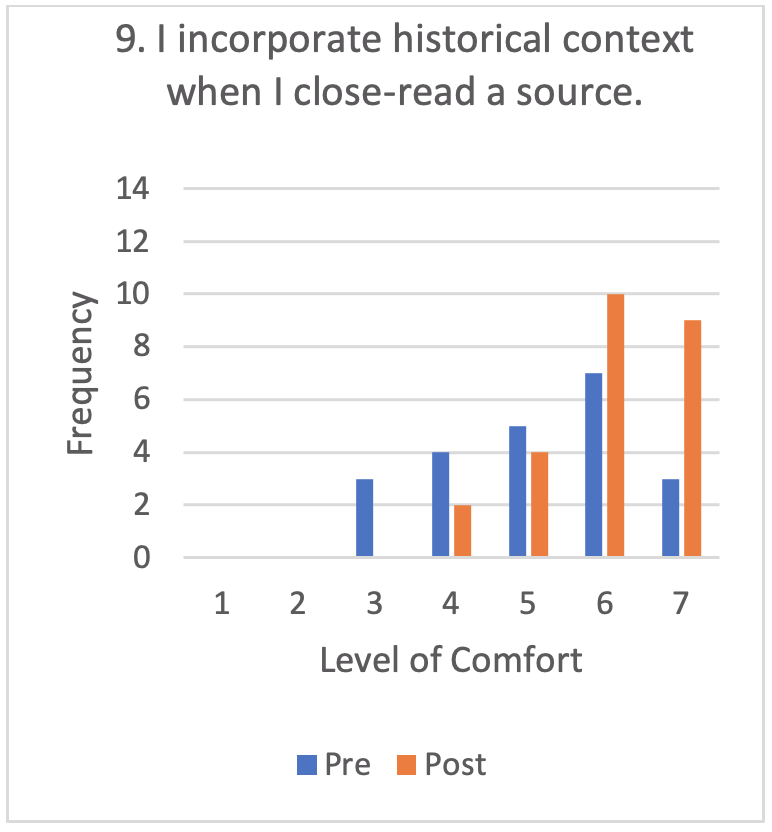DIV 6800: History of Global Christianities II: Creative Historical Imagination
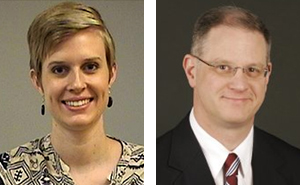 Erika Nelson working with
Erika Nelson working with
James Hudnut-Beumler, Professor of History
Area for Pedagogical Improvement
Having been the teaching assistant for History of Global Christianities II for 4 years I had begun to notice a tendency in my students to view history has a series of isolated events. We covered a period in history, had the test on that period, and then moved on. There was very little engagement with history as a comprehensive narrative across time. I viewed this as an area that desperately needed to be improved upon. The idea of history as only names and dates that one needs to memorize is neither effective pedagogy nor does it capture what history actually is. Certainly, individual moments and facts are important to understand; I couldn’t call myself a historian of the Revolutionary War if I didn’t know that it started in 1775. But history is so much more than that. It is a narrative that has multiple angles and infinite points of connection. The problem I faced was how to inculcate this view of a comprehensive history, without sacrificing the importance of individual moments in time.
The first step to helping my students understand history in this way was to precisely define what I was trying to achieve. I labelled this view Creative Historical Imagination. It has three prongs:
1. The ability to see trends across time periods
- Students should understand that history is more than just looking at one specific time period, rather American history is a long story of interconnected events.
- For example, the Great Awakening had many impacts on the way that modern evangelicals preach.
2. The ability to understand comprehensive historical cause and effect
- This is part of where the creative aspect comes in. History is never simple, so students should be able to look for potential causes and effects in many places and communities. Part of this is the ability to research properly in order to find those creative solutions.
- For example, it is not accurate to simply say “slavery caused the Civil War.” Rather, slavery was one component that interacted and influenced many others factors (such as economics, religion, racism, electoral politics, etc.) in the growing and complicated division between Northern and Southern states.
3. The ability to critically read texts (texts here refers to all sources used in historical inquiry, such as images, written words, videos, even artifacts of material culture)
- This involves both close reading of the text itself and an interpretation based on the historical context. Critical reading is of key importance to fully understanding a specific historical moment.
- For example, students often interpret sources based on emotional reactions or they restate in simpler language what the source says. While this is certainly valid, students need to move beyond that reaction to delve into the who, what, where, why, when, and how of a certain text.
Proposed Solution
I developed a project to help my students develop creative historical imagination in a way that was doable in one semester. At its core the project is a comparative annotation assignment. Students were asked to come up with a historical trend that was compelling to them. I explained to the students that a trend was not only a topic, but an exploration as to how topic changes over time. For example, one student looked at how Quakers’ attitudes towards war shifted as their political power waned over time. Another student looked at the way the arson against Black churches was reported in the media as Jim Crow gave way to the Civil Rights movement. This was a way for students to engage with material that was outside of the course or to delve more deeply into something that we covered peripherally.
The project had three parts:
1. Annotation of Pre-1900 Source.
Students were asked to select a written source that was related to their trend from before 1900. The students were asked to use an online annotation website called XODO, or Adobe pdf annotation software.
2. Annotation of Post-1900 Source.
Students were then asked to find a video from after 1900, also related to their trend. (Youtube was the most accessible video library platform.) Then students were taught how to use a video annotation website called Reclipped in order to annotate their video.
3. Synthesis Paper
Building on the two annotation assignments, students wrote a paper in which they made an argument about their trend. They were asked “how did it change?” or “if it didn’t change, why is that?”
Methods of Analysis
So, how did I determine if this was an effective project? I engaged 3 different means of analysis: a survey, a reflection assignment, and a focus group.
1. Survey: I gave my class a survey which asked students’ confidence levels in various tasks, related to creative historical imagination. I gave the same survey before and after the project. While this doesn’t measure concrete ability, the students’ own perceptions of their learning are incredibly valuable. This is especially true as my class was comprised of all masters of divinity students, who as a population are very in-tune with their internal sense of self and their related abilities. (Pre-Survey had a 67% response rate and the post-survey had a 75% response rate, out of 33 students.)
2. Reflection Assignment: I gave the students a reflection assignment as my second measure of analysis for this project. Students were asked to write 1-2 pages reflecting on how this assignment impacted or changed the way that they viewed history, if it did so. Here I wanted to capitalize on my student’s proven ability to express themselves in a freer format.
3. Focus group: For my third measure, I used a service provided by Vanderbilt’s Center for Teaching. This is when a staff member from the CfT comes into the classroom and facilitates a small group discussion on a specific topic, without the presence of the instructor. This allows the students to give qualitative feedback anonymously, which increases the likelihood of that feedback being honest.
Results and Discussion
Finally, was I able to help my students develop a creative historical imagination? The answer, I am happy to report, is an overwhelming yes. The survey results showed a marked increase in confidence across the board, with the most notable increase being confidence in close-readings. The survey also showed that students felt that the assignment added to their overall learning. In the reflection assignments, it was striking how many students addressed the exact prongs of creative historical imagination, despite the fact that this breakdown was never provided for the students. Many students spoke about the ways that this project changed their view of history overall. The focus group showed that the students grasped the main point of the project. It also showed that students felt that the technology and annotation skills they gained were useful for their future academic career.
Based on all of these factors, which will be explored in more detail below, I can confidently conclude that the comparative annotation assignment did inculcate in the students a sense of creative historical imagination. Moreover, students understood this skill, and the assignment overall, to be useful and interesting.
Overall, students found this assignment useful to their learning. When asked this question directly 87% of students responded 6 or 7. This overwhelming positivity about the overall effectiveness shows the extent to which students enjoyed and learned from this project. It also communicates in statistical form the excitement I saw as an instructor. Students were deeply engaged in their individual topics and their reflection papers showed how enthusiastic they were to explore history using the creative historical imagination they developed. One student said “Out of completing this assignment, which was of great interest to me as someone who loves history, grew an even deeper respect for history. I now view history as not just a subject, but a tool for which to experience the past.” Even for students who already loved history, this project helped them refine and complexify their understanding of history as a tool. Students truly gave their all with this assignment. As an instructor I was thrilled by fascinating topics that my students selected and the level of analysis with which they engaged these assignments. As a history teacher, what more could I ask for? As far as the specific results, I have organized them per the 3 prongs of creative historical imagination, with an additional section about the technology used.
1. Ability to See Trends Across Time Periods
Through the survey, students expressed an increase in confidence in their ability to understand and discuss historical trends and to connect two disparate historical events. While in questions 1 and 3 the most frequent level of confidence actually went down, the general trend was still an increase. This could be because of the Dunning-Kruger effect, which says that novices have a tendency to overestimate their abilities. Another possible explanation comes from the focus group. Students noted that it was difficult to make claims about a larger trend using only two sources. While this is a critique of the assignment, it is a critique which shows an even deeper understanding of what is required to analyze historical trends. The students are correct, two events are not enough. (But, in order for the assignment to be doable within the class we limited it to two sources, which is not something I would change because it would make the assignment a very difficult and lengthy research paper.) However, the fact that the students showed an understanding of how difficult it is to make these claims is actually a mark of how much they learned regarding the connectivity and comprehensiveness of historical trends.
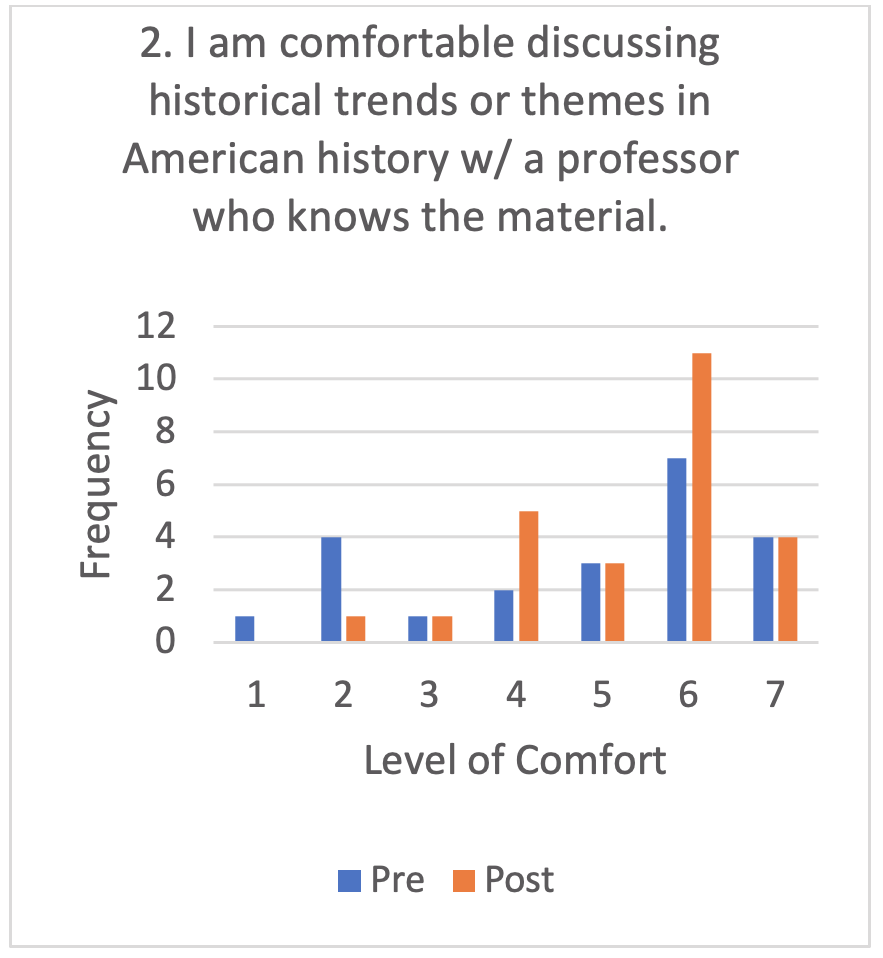 |
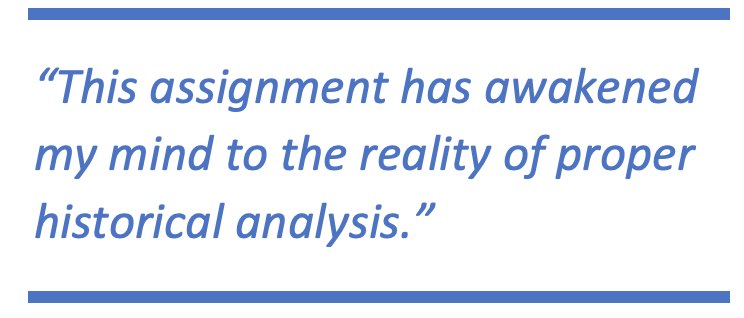 The qualitative data I received, both from their reflection assignments and the focus group, showed that not only did the students believe that they improved upon this ability, they were able to demonstrate it through their work and understanding of the project. In the reflection assignments, many students spoke directly to the ability to see trends across time. One student remarked “Getting to see how those things connect, some of the influences that changed those connections, and even how my specific topic has had an impact on history, has brought my mind to a place of contemplating how connected everything is.” Another student furthered this idea by saying “This assignment has awakened my mind to the reality of proper historical analysis. In connecting various historical events as a scholar, I can have a deeper and broader knowledge and understanding of a particular topic. Therefore, it is essential to deal with history wholesomely rather than sections.” Both of these students showed that they understood the importance of viewing history comprehensively. They also both noted that the assignment specifically helped them to arrive at this view.
The qualitative data I received, both from their reflection assignments and the focus group, showed that not only did the students believe that they improved upon this ability, they were able to demonstrate it through their work and understanding of the project. In the reflection assignments, many students spoke directly to the ability to see trends across time. One student remarked “Getting to see how those things connect, some of the influences that changed those connections, and even how my specific topic has had an impact on history, has brought my mind to a place of contemplating how connected everything is.” Another student furthered this idea by saying “This assignment has awakened my mind to the reality of proper historical analysis. In connecting various historical events as a scholar, I can have a deeper and broader knowledge and understanding of a particular topic. Therefore, it is essential to deal with history wholesomely rather than sections.” Both of these students showed that they understood the importance of viewing history comprehensively. They also both noted that the assignment specifically helped them to arrive at this view.
The focus group also confirmed that students understood the point of the project, which is necessary both to engage students and to encourage the specific form of learning I aimed to improve. Out of 10 groups, all 10 of the groups noted the point of the project was to, in the words on of one group, “analyze trends across history and to engage history in a new way.” This shows both that the project was clearly communicated to the students and that the exercises connected strongly with the stated objectives.
2. Ability to Understand Comprehensive Historical Cause and Effect
The survey showed that the students improved upon their understanding of cause and effect and their confidence in researching it. In the pre-project surveys, students’ responses were somewhat all over, with higher points in the middle. Some students were more confident than others, but there was not a concentration of high confidence. In the post-project surveys, the answers were confined to 4-7, which is an improvement in itself. The majority of answers were in the 5-7 range, with 5 or 6 being the most frequent number. Finally, the 6s and 7s increased by 25 overall. So, the students are significantly more confident in terms of both cause and effect generally and engaging in research in order to accomplish this.
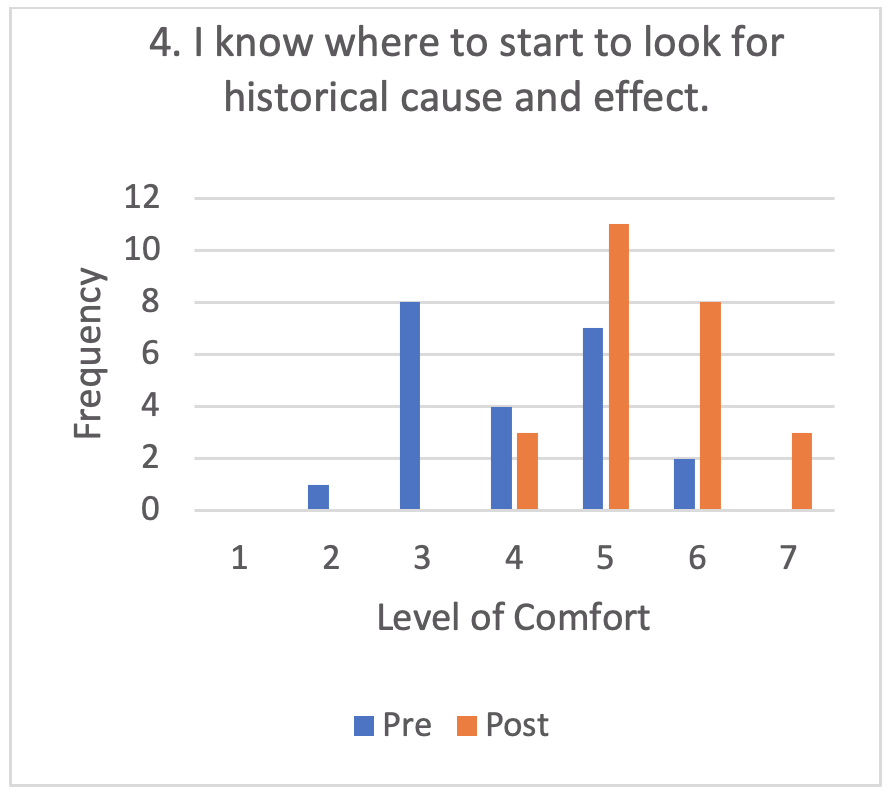 |
 |
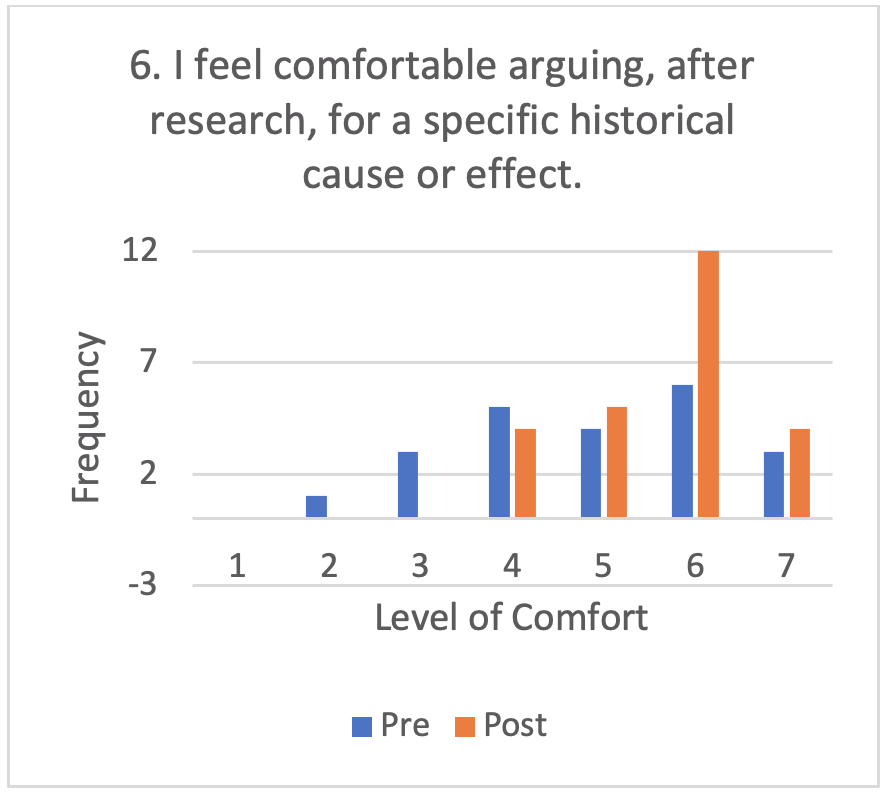 |
Qualitatively, the students also showed an understanding of historical cause and effect. First, purely through the completion of the assignment itself students showed that they were able to find events that were connected via historical cause and effect. They learned how to do small-scale research in order to find their two pieces. As mentioned before, part of the category of “cause of effect” is conducting research. To analyze historical cause and effect, students must know where and how to look for it, which is research. Through the focus group, students reflected that one of the abilities they g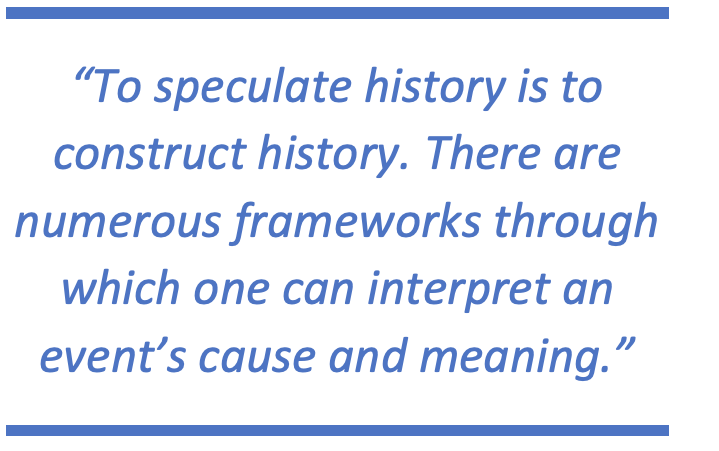 ained through this project was research skills. In an open ended question about skills gained, 6 of the 10 groups mentioned something about research. One group stated the “one of the unexpected outcomes was learning how to navigate library systems and tools.” This fact that this skill was “unexpected” shows me that these students hadn’t been guided through research skills in previous history classes. When given a research project, students were surprised to be taught how to research. In my experience, oftentimes students are expected to know how to research but it is not a skill that is taught frequently. This project sought to change that, and given the responses in the focus group, it was successful at doing so.
ained through this project was research skills. In an open ended question about skills gained, 6 of the 10 groups mentioned something about research. One group stated the “one of the unexpected outcomes was learning how to navigate library systems and tools.” This fact that this skill was “unexpected” shows me that these students hadn’t been guided through research skills in previous history classes. When given a research project, students were surprised to be taught how to research. In my experience, oftentimes students are expected to know how to research but it is not a skill that is taught frequently. This project sought to change that, and given the responses in the focus group, it was successful at doing so.
Regarding the reflection papers, sometimes in the wording cause and effect was difficult to separate out from historical trends, but this is understandable given that the two topics are closely related. Despite this, several students did speak directly to the nuance of cause and effect in their responses. One student wrote “To speculate history is to construct history. There are numerous frameworks through which one can interpret an event’s cause and meaning, ideologies which can justify or condemn, and stylistic choices which can subliminally convey the nuance of a situation.” This student profoundly wrote about the implications of determining an event’s cause and effect. They showed that it is always a narrative constructed by the historian. Historians use established frameworks and historical critical analysis to arrive at their conclusions, but it is still an exercise of construction. This is above and beyond what I was hoping to inculcate in the students. While other responses didn’t reach quite this level of nuance, other students did address cause and effect. Another student expressed that before the project, “[she] have been one to flippantly make remarks such as, ‘that was the past, this is the present and things are different now!’” After the project she understands that “when we take a closer look at anything today, we will see how its beginnings and development continue to shape its understanding and evolution over time; sometimes for the better, other times for worse.” She notes here that looking for cause and effect is not a singular event, that things evolve over time. She also brings up an important part of historical analysis that many of my students stumbled upon. Sometimes what you learn is difficult to process (such as the student who explored the influence of Puritan condemnation of lust on the violent language used by Evangelical Christians to describe sexual sins); but it is important to shed light on all aspects of the American experience. That is part of the beauty and burden of historical study.
3. Ability to Critically Read Texts
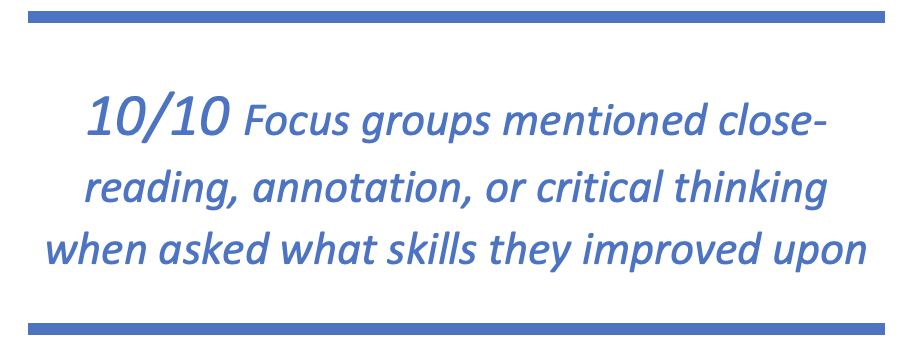 This category was the most improved in terms of student confidence levels. Question 7 asked about if students knew what it meant to close read a primary source. The most frequently selected number was 5 before the assignment, after the project about 60% of the class rated their confidence at a 7. The other two questions related to close-reading all showed similar, if not quite so drastic, results. This is also bolstered by the focus group data. When asked what skills they improved upon, 10 out of 10 groups mentioned source annotation, close-reading, or critical analysis. The nature of the project, with two different annotation assignments, allowed the students to really hone their close-reading skills.
This category was the most improved in terms of student confidence levels. Question 7 asked about if students knew what it meant to close read a primary source. The most frequently selected number was 5 before the assignment, after the project about 60% of the class rated their confidence at a 7. The other two questions related to close-reading all showed similar, if not quite so drastic, results. This is also bolstered by the focus group data. When asked what skills they improved upon, 10 out of 10 groups mentioned source annotation, close-reading, or critical analysis. The nature of the project, with two different annotation assignments, allowed the students to really hone their close-reading skills.
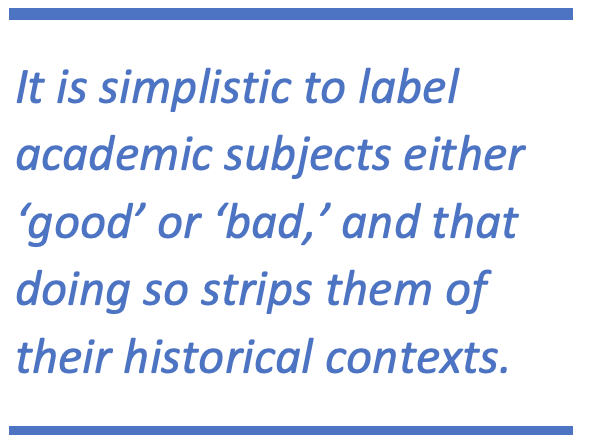 In the reflection papers, there was not as much direct reference to close-reading or annotations. But the students were asked to reflect on more big-picture concepts, so that is to be expected. However a several students did reference the annotations as integral to their final papers, in terms of the way close-reading supported their overall conclusions. One student in particular referenced her ability to understand sources more deeply. “Exploring the relationship between…two distinct historical time periods illuminated a great deal about the underbelly of American experiences. Namely that it is simplistic to label academic subjects either ‘good’ or ‘bad,’ and that doing so strips them of their historical contexts. It is imperative to understand the context from which the subject was speaking as it highlights changing attitudes in America.” This student showed that she understood the complexity of analyzing sources from different time periods. Sometimes it is difficult to hold back judgement, especially when the source is contrary to what we believe personally. But in order to truly understand a historical moment or a time period we must use historical context to understand the way the author thought. This comment is particularly relevant for me because this issue is one of the reasons I started the project to begin with. In a previous iteration of this class I had many students who grouped sources as “good” or “bad” depending on their personal beliefs. This led to discussion sections that were solely about student’s opinions, rather than about analyzing historical attitudes and contexts. That class shaped my learning outcomes for this project. To see a student with no knowledge of that background reference the need to go beyond simple good and bad is truly wonderful. It shows me that my learning goals were achieved. These students, both through their ability to research and their deep understanding of the importance of historical context are prepared for any close-reading or critical thinking that will be required of them in the future.
In the reflection papers, there was not as much direct reference to close-reading or annotations. But the students were asked to reflect on more big-picture concepts, so that is to be expected. However a several students did reference the annotations as integral to their final papers, in terms of the way close-reading supported their overall conclusions. One student in particular referenced her ability to understand sources more deeply. “Exploring the relationship between…two distinct historical time periods illuminated a great deal about the underbelly of American experiences. Namely that it is simplistic to label academic subjects either ‘good’ or ‘bad,’ and that doing so strips them of their historical contexts. It is imperative to understand the context from which the subject was speaking as it highlights changing attitudes in America.” This student showed that she understood the complexity of analyzing sources from different time periods. Sometimes it is difficult to hold back judgement, especially when the source is contrary to what we believe personally. But in order to truly understand a historical moment or a time period we must use historical context to understand the way the author thought. This comment is particularly relevant for me because this issue is one of the reasons I started the project to begin with. In a previous iteration of this class I had many students who grouped sources as “good” or “bad” depending on their personal beliefs. This led to discussion sections that were solely about student’s opinions, rather than about analyzing historical attitudes and contexts. That class shaped my learning outcomes for this project. To see a student with no knowledge of that background reference the need to go beyond simple good and bad is truly wonderful. It shows me that my learning goals were achieved. These students, both through their ability to research and their deep understanding of the importance of historical context are prepared for any close-reading or critical thinking that will be required of them in the future.
4. Technological Aspects of the Project
There were a few aspects of the project which didn’t fall neatly into the 3 Creative Historical Imagination categories, which were more related to the technological pieces of the project. In the post-project survey, students were asked if the Youtube annotation software, Reclipped, was useful to their learning 78.2% of respondents answered 5, 6, or 7, with the majority being 6 or 7. So, almost all of the class found Reclipped useful and were pleased to have learned how to use it. The focus group data also proves this, 6 out of 10 groups mentioned the video annotation software as either a new skill they learned or as aspect of the assignment that was helpful to their learning. One group even said that video annotation software “is really cool.” The technology in this case bolstered, or perhaps in some cases facilitated, the learning that occurred as a result of this project. Reclipped made the annotation assignments interesting, and that interest increases student learning.
The only aspect of the project that would need to change in order for it to happen again is the pdf annotation software, for the pre-1900 source. I selected a free online tool called xodo. After testing it on my own computer it seemed like an easy-to-use program. However, we learned in the middle of the project that it did not work well on older macs and didn’t work on newer macs at all. In the focus group, several groups mentioned the the xodo software as something that could be improved. So, while the video annotation software was very successful, an equally effective software must be found for pdf annotation.
Conclusion
Overall, the success of this assignment is about so much more than the numbers and the graphs. The passion that I saw in these students grew as they learned more about their topic. As the parts of the project were dispersed throughout the semester, many students were able to use their theme as a through-line in the class. Their interest and analytical ability grew in equal measure as the semester progressed. They often brought up in the discussion sections how specific readings related to their topic. We also provided time to share how their projects were progressing so that the students learned from each other. Though these moments I could see that many students used their project as a kind of anchor. They knew that they needed to be looking for the interconnectedness of history, but that can be a daunting prospect when you are looking at a long, detailed survey of American history. Their projects allowed the students to focus in one topic that was interesting to them and understand change that way. In short, this project gave students the ability to apply creative historical imagination to other classes or historical inquiries in a way that was manageable and even enjoyable!


